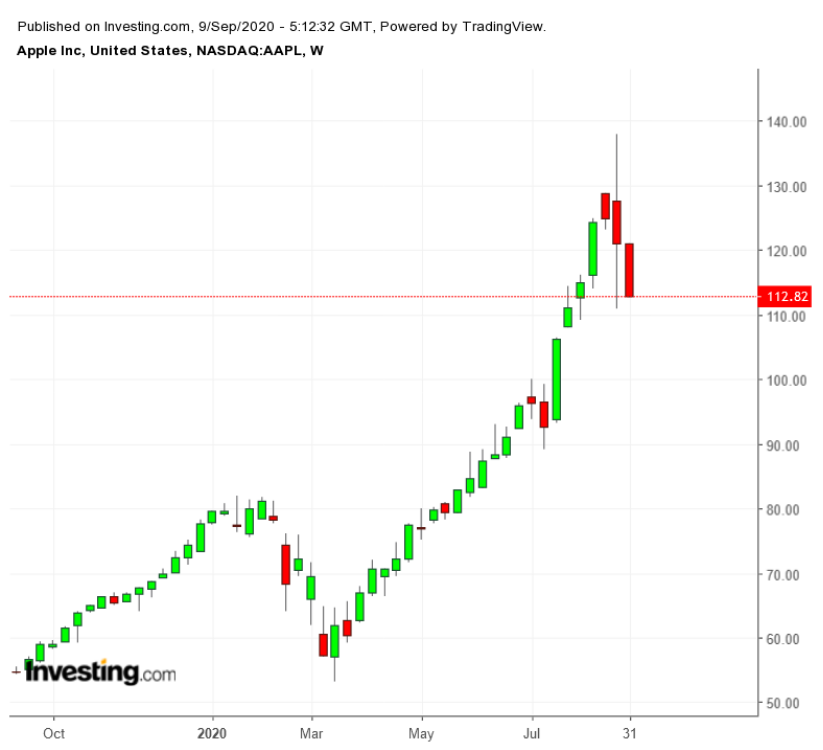With the sell-off in equities deepening and investors rushing to safety, technology shares are the most vulnerable area of the market, after a powerful rally in recent months stretched valuations toward levels last seen during the dot-com era.
In this correction, iPhone-maker Apple (NASDAQ:AAPL) is more exposed than the other two technology titans in the trillion-dollar market-cap club—Amazon (NASDAQ:AMZN) and Microsoft (NASDAQ:MSFT).

Below, we summarize three key risks to Apple stock after a powerful rally saw it gain more than 80% between March and Sept. 1, when the current downleg began. Apple shares are down almost 16% since then, closing yesterday at $112.82.
1. Still Too i-Phone Dependent
One of the major reasons that investors remain excited about the Apple is the company’s successful drive to diversify its revenue base beyond iPhones. In recent years, Apple has proven that it can use its massive customer roster to unlock new areas of growth when demand for its flagship products weakens.
In the 2019 fiscal year, the company’s iPhone business accounted for about 55% of total sales, while the services segment—which includes Apple Music, movie rentals and app downloads—made up approximately 18% of revenue.
Despite this impressive performance, some analysts believe the growth in services isn’t strong enough to make up for the decline in its hardware business.
Goldman Sachs, which yesterday cut Apple’s price target by 33% to $80 a share, says it doesn’t believe the non-iPhone segments of the business will be able to make Apple a true growth company again. As its analyst note on this said:
“Our big picture view of Apple is grounded in the idea that the iPhone is a very tough act to follow, with services and wearables not likely to be large enough to return the company to growth.”
The bank even compared Apple with Intel (NASDAQ:INTC), saying that the company’s data center business wasn’t enough to offset the decline of personal computers, leading to a struggling stock since 2012.
2. China Exposure
Among the mega-cap tech stocks, Apple is most exposed to the worsening relations between the US and China. Over the last few years, Apple has constructed a large network of suppliers in China in order to reduce costs. As a result, it has become one of the most exposed stocks to the Asian country.
The California-based tech giant employs an estimated 2 million people within the Apple supply-chain, in addition to a similar number of tech workers involved in the development of Apple apps.
The company designs and sells most of its products in the US, but imports them from China after assembly. Virtually all iPhones are made by Foxconn’s Hon Hai Precision Industry Co. in Zhengzhou, China, and by Pegatron, at an assembly site near Shanghai.
President Donald Trump said yesterday that he intends to further reduce the US economic relationship with China, threatening to punish any American companies that create jobs overseas. He has also said he would forbid companies that do business in China from winning federal contracts.
On the tech front, the Trump administration is moving to prevent China from accessing US user data on popular apps like WeChat and TikTok. The US is also moving to shut out Huawei from access to US technologies and equipment.
3. High Valuation
Apple, now valued at about $2 trillion, trades at more than 31 times forward earnings—its richest multiple in more than a decade.
There are many valid reasons that fuelled this optimism and prompted analysts to re-rate this stock, including a belief that Apple will launch its first 5G iPhone later this year, and that the company’s service revenues continue to grow and diversify its dependence away from the transactional hardware side.
But now that its stock is priced for perfection, the company has little room to disappoint its investors. The sell-off in Apple stock accelerated after the Nikkei Asia Review reported on Tuesday that mass production of the company’s newest line of iPhones is expected to begin ramping up in mid-September and into early October. Production was anticipated to begin at the end of August.
The company is expected to produce around 75 million iPhones this year, which is short of the 80 million phones for which it ordered components, sources told the newspaper. The remainder of Apple's planned production could be pushed into early 2021, Nikkei said.
“To turn more positive on Apple’s stock and disprove this thesis, we would like to see the company delivering repeated revenue/EBIT beats against consensus expectations with revenue and profit growth increasing,” stated the note issued by the Goldman Sachs.
Bottom Line
Apple faces a greater downside risk than other tech giants in the current corrective phase. But that weakness is healthy in our view, offering investors a good opportunity to buy the company’s shares at a much more attractive price.
Which stock should you buy in your very next trade?
With valuations skyrocketing in 2024, many investors are uneasy putting more money into stocks. Unsure where to invest next? Get access to our proven portfolios and discover high-potential opportunities.
In 2024 alone, ProPicks AI identified 2 stocks that surged over 150%, 4 additional stocks that leaped over 30%, and 3 more that climbed over 25%. That's an impressive track record.
With portfolios tailored for Dow stocks, S&P stocks, Tech stocks, and Mid Cap stocks, you can explore various wealth-building strategies.

